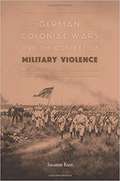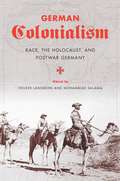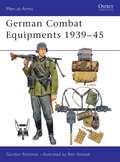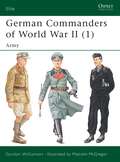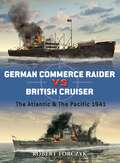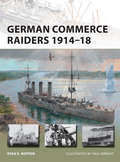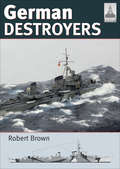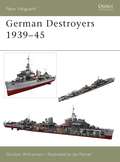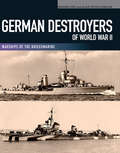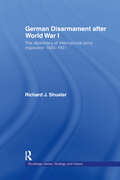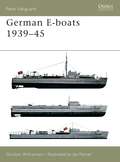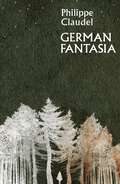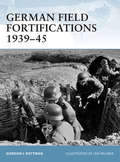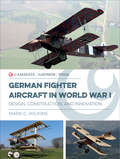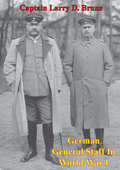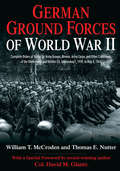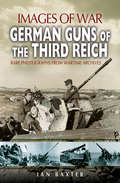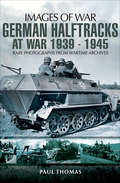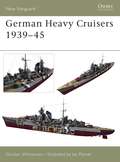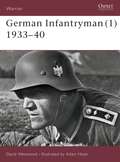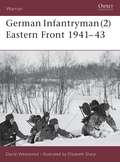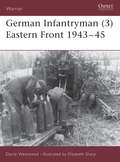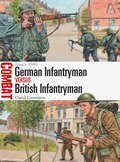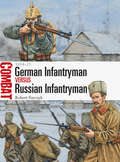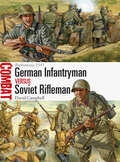- Table View
- List View
German Colonial Wars and the Context of Military Violence
by Susanne KussSome historians have traced a line from Germany’s atrocities in its colonial wars to those committed by the Nazis during WWII. Susanne Kuss dismantles these claims, rejecting the notion that a distinctive military ethos or policy of genocide guided Germany’s conduct of operations in Africa and China, despite acts of unquestionable brutality.
German Colonialism: Race, the Holocaust, and Postwar Germany
by Mohammad Salama Volker LangbehnMore than half a century before the mass executions of the Holocaust, Germany devastated the peoples of southwestern Africa. While colonialism might seem marginal to German history, controversial new scholarship compares the acts of this period with Nazi practices on the Eastern and Western fronts. Examples of the most important research conducted on the "continuity thesis" over the past five years, the chapters in this anthology debate the connections between German colonialist activities and the behavior of Germany during World War II. Some argue that the country's domination of southwestern Africa gave rise to perceptions of racial difference and superiority at home, contributing to a nascent nationalism that blossomed into National Socialism and the Holocaust. Others remain skeptical, and both sides are well-represented. Contributors merge Germany's colonial past with debates over the country's identity and history and compare its colonial crimes with other European ventures. Issues discussed range from the denial or marginalization of German genocide to the place of colonialism and the Holocaust within Germany and Israel's postwar relations. Authors also compare the legacy of genocide in both Europe and Africa.
German Combat Equipments 1939-45
by Gordon Rottman Ronald VolstadThe field equipment of the German Army in World War II was closely related to that used throughout World War I and earlier, yet it was of relatively light weight, ruggedly constructed, well designed, functional, and generally of a high quality, though this deteriorated in the later war years. A high degree of design standardisation was maintained in most categories of equipment, though materials and their colours often varied widely. There were also many different specialisations for the various arms of service as well as theatres of combat, such as the Afrikakorps in the Western Desert. This title investigates all manner of German combat equipments throughout World War II, from belt buckles to magazine pouches.
German Commanders of World War II
by Gordon Williamson Malcolm McgregorThis first of two studies examines the careers and illustrates the appearance and uniforms of 19 of the German Army's leading field commanders in World War II (1939-1945). Their service covers the whole arc of that army's wartime experience, from stunning success in 1939-41, through the hugely costly middle years on the Russian Front to the stubborn defensive fighting in both East and West in 1943-45. Also included are five more junior unit commanders chosen because their service typifies the achievements of combat leaders in regimental and battalion commands. The colour portraits are in the uniquely meticulous style of the respected World War II illustrator Malcolm McGregor.
German Commerce Raider vs British Cruiser
by Robert Forczyk Ian PalmerDuring World War II, the Kriegsmarine armed a number of merchant vessels with concealed guns and torpedo tubes for surprise attacks against Allied shipping. To counter this deadly threat, the Royal Navy employed cruisers and their intelligence-gathering apparatus to find and destroy the disguised German commerce raiders. This Duel title covers the deadly game of cat and mouse, fought by these surface vessels during World War II.
German Commerce Raiders 1914-18
by Paul Wright Ryan NoppenThis is the story of Germany's commerce raiders of World War I, the surface ships that were supposed to starve the British Isles of the vast cargoes of vital resources being shipped from the furthest reaches of the Empire. To that end pre-war German naval strategists allocated a number of cruisers and armed, fast ocean liners, as well as a complex and globe-spanning supply network to support them - known as the Etappe network. This book, drawing on technical illustrations and the author's exhaustive research, explains the often overlooked role that the commerce raiders played in World War I. Whilst exploring the design and development of the ships, it also describes their operational history, how they tied up a disproportionate amount of the British fleet on lengthy pursuits, and how certain raiders such as the SMS Emden were able to wreak havoc across the oceans.
German Destroyers (Shipcraft Ser. #25)
by Robert BrownThis fully illustrated guide to building model ships covers a variety of WWII era German destroyers with info on accessories and kits of various scales. The &‘ShipCraft&’ series provides in-depth information about building and modifying model kits of famous warship types. Lavishly illustrated, each book takes the modeler through a brief history of the subject class, highlighting differences between sister-ships and changes in their appearance over their careers. Paint and camouflage details are shown with color profiles, line drawings, and scale plans. The modeling section reviews the strengths and weaknesses of available kits, lists commercial accessory sets, and provides hints on modifying and improving the basic kit. This is followed by an extensive photographic gallery of high-quality models in a variety of scales. Each volume concludes with a section on research references, including books, monographs, large-scale plans and websites. This volume covers the large and powerful German destroyers of the Second World War era. Always popular as modelling subjects, interest in them has been further increased recently by the release of a number of very fine large-scale kitsThe &‘ShipCraft&’ series provides in-depth information about building and modifying model kits of famous warship types. Lavishly illustrated, each book takes the modeler through a brief history of the subject class, highlighting differences between sister-ships and changes in their appearance over their careers. This includes paint schemes and camouflage, featuring color profiles and highly detailed line drawings and scale plans. The modeling section reviews the strengths and weaknesses of available kits, lists commercial accessory sets for super-detailing of the ships, and provides hints on modifying and improving the basic kit. This is followed by an extensive photographic gallery of selected high-quality models in a variety of scales, and the book concludes with a section on research references – books, monographs, large-scale plans and relevant web sites. This volume covers the large and powerful German destroyers of the Second World War era. Always popular as modeling subjects, interest in them has been further increased recently by the release of a number of very fine large scale kits. With its unparalleled level of visual information – paint schemes, models, line drawings and photographs – this book is simply the best reference for any model maker setting out to build one of these unusual ships.
German Destroyers 1939#45
by Ian Palmer Gordon WilliamsonThe German destroyer fleet of World War II consisted of nine classes: the Diether Von Roeder Class, the Leberecht Maas Class and the wartime classes Z23, Z35, Z37, Z40, Z43, Z46 and Z52. These vessels, though fewer in number than the British destroyer fleet, tended to be much bigger and more powerful than their allied counterparts. They served their country well in operations in the Channel, North Sea, the Far North and in the rescue of civilians from East Prussia during the final days of the war. This title describes their design, development and operational use from the fjords of Narvik to the final days of the war.
German Destroyers of World War II: Warships of the Kriegsmarine (Warships Of The Kriegsmarine Ser.)
by Gerhard Koop Klaus-Peter SchmolkeA detailed, illustrated history of the torpedo boat destroyers of the Nazi German Navy. The warships of the World War II German Navy are among the most popular subjects in naval history, and one of the best collections is the concise but authoritative six volume series written by Gerhard Koop and illustrated by Klaus-Peter Schmolke. Each book contains an account of the development of a particular class, a detailed description of the ships, with full technical details, and an outline of their service, and are heavily illustrated with plans, battle maps and a substantial collection of photographs. This volume in the series details the more than 40 German destroyers, including captured ships that saw service during World War II. Chapters range from their design and development, armament and machinery, to the differences in appearance, camouflage schemes, and modifications. This book also covers the destroyers&’ careers and the many actions they fought, complemented by illustrated plans, technical drawings, maps, and a comprehensive gallery of photographs.
German Disarmament After World War I: The Diplomacy of International Arms Inspection 1920-1931 (Strategy and History)
by Richard J. ShusterGerman Disarmament After World War I examines the Allied disarmament of Germany and the challenges that such an enormous task presented to international efforts in enforcing the Treaty of Versailles. In the twenty-first century, disarmament remains a critical issue for the International community. This new book focuses on three key areas and lessons of Allied disarmament operations from 1920-31: the role and experience of international arms inspectors working amidst an embittered German populace the ramifications of the divergent disarmament priorities of the leaders of the disarmament coalition the effectiveness of united Allied policies backed by sanctions. These major issues are examined within the overall context of the assessment of Allied disarmament operations in Germany. While some historians perceive German disarmament as a failure, this book argues that arms inspectors successfully destroyed Germany’s ability to pose a military threat to European security. This new study shows how the destructive legacy of war convinced the victorious nations, especially Britain and France, of the importance in minimizing German military strength. French post-war security concerns, however, were often faced with the unwillingness of Britain to enforce the totality of the military articles of the treaty. German obstruction also influenced Allied disarmament policies. German Disarmament After World War I examines the initial effectiveness of Allied disarmament efforts in Germany and explains how they ultimately disappeared through diverging conceptions of a post-war world. This book will be of great interest to all students of disarmament, the interwar period and of military history, modern European history and security studies.
German E-boats 1939-45
by Ian Palmer Gordon WilliamsonBy the outbreak of World War II, Germany had done much to replace the Kaiser's High Seas Fleet, which was scuttled following their surrender at the end of World War I. Forced to build anew, the Kriegsmarine possessed some of the most technically advanced warships in existence. Although the heavy units of the fleet were too small in number to pose much of a threat, Germany was particularly well served by her Navy's smaller vessels, in particular the U-Boats and the S-Boats. Known to the allies as the E-Boats ('Enemy'), they performed sterling duties in the Black Sea and English Channel, where they became a particular scourge.
German Fantasia
by Philippe ClaudelA deserting soldier treks through the torn-up countryside and abandoned villages, trying to distance himself from the atrocities of war.An elderly man sits beneath lime trees, remembering his first sexual encounter one summer night with a female stranger who whispered another man's name.A young woman takes up a job in a care home, spending monotonous days scrubbing floors and yearning to dance at the local nightclub.The artist Franz Marc lives on in an imagined life as a patient at an asylum, before falling victim to Hitler's policy of Gnadentod.Finally, a young Jewish girl, the life she once knew destroyed, holds her memories close as she finds refuge in wreckage of her homeland.And throughout there is the shadowy presence of Viktor - one man or many? A looming figure in Germany's own reckoning with its past.Through these five interconnected stories, Philippe Claudel reflects on Germany's complex history and the experiences of its people, dismantling the idea of "a nation" or "a people" and exploring the malleability of memory.
German Field Fortifications 1939-45
by Gordon Rottman Ian PalmerThe German Army of World War II considered itself an offensive, mobile force. The experiences in the trenches in World War I had done much to shape its concept of field fortification, and its mobile warfare ethos was intended to prevent the previous war's stalemate. This book addresses frontline defensive field fortifications, built by infantrymen using local materials, and includes rifle platoon positions, trenches, crew-served weapon positions, bunkers, dugouts, shelters and more. It also covers anti-tank and anti-personnel obstacles, as well as field camouflage methods and construction methods. The integration of these positions into permanent systems and theatre-specific defences are also discussed.
German Fighter Aircraft in World War I: Design, Construction and Innovation (Casemate Illustrated Special #Ciss0002)
by Mark C. WilkinsThis fully illustrated volume explores German military aviation during WWI through archival photographs and authentically detailed replicas. Fighter aircraft were developed during World War I at an unprecedented rate, as nascent air forces sought to achieve and maintain air supremacy. German manufacturers innovated at top speed, while constantly scrutinizing the development of new enemy aircraft. The Germans also utilized the concept of modular engineering, which allowed them to disassembled or reassembled their aircraft quickly in the field. The pinnacle of their aeronautical innovations was the iconic Fokker D VII—the only aircraft specifically mentioned in the Treaty of Versailles, which forbade Germany from building it after the war. German Fighter Aircraft in World War I explores how German fighter aircraft were developed during the war, the advancements and trials that made the Fokker D VII possible, and the different makes and types of aircraft. Using unpublished images including photographs of surviving aircraft, archive images, and models and replicas, this volume shows details of aircraft that were kept top secret during the war. Extensively illustrated with 140 photos and ten color profiles, this is will be essential reading for all WWI aviation enthusiasts and modelers.
German General Staff In World War I
by Captain Larry D. BrunsThis study reviews the problems of the German General Staff during the First World War in an attempt to highlight successes and understand failures. The investigation focuses on the traditional staff functions of intelligence, operations, logistics and command, control and communications. To obtain a comparison, two epic battles on the Western Front were used, the Battle of the Marne in 1914 and the first spring offensive, Michael, in 1918. This study revealed that the German General Staff did an excellent job in staff thought, planning and execution. However, in the area of command, control and communications they were not as capable. The defeat at the Marne and the eventual failure of Michael were the result of command, control and communications problems which prevented the German General Staff from placing needed forces at a decisive point and time to obtain a strategic victory. These command, control and communications problems provide a constant underlying theme for the defeat of German forces in the First World War. The United States Army faces many of the same command, control, and communications problems faced by the German General Staff almost seventy years ago. This study highlights the German errors so that United States Army will not make the same mistakes.
German Ground Forces of World War II: Complete Orders of Battle for Army Groups, Armies, Army Corps, and Other Commands of the Wehrmacht and Waffen SS, September 1, 1939, to May 8, 1945
by William T. McCroden Thomas E. NutterGerman Ground Forces of World War II offers the first comprehensive order of battle for German ground troops throughout the Second World War, from the invasion of Poland on September 1, 1939, to the destruction of the last remnants of Germany’s Wehrmacht and Waffen SS in Berlin in 1945. Unlike similar works, these orders of battle are dynamic, and so account for the continuously changing character of Germany’s ground forces at war. This massive new reference work by McCroden and Nutter, broken up in sections including Theater Commands, Army Groups, Armies, and Corps Commands, presents a detailed analysis of each corresponding order of battle for every German field formation above division. Additional new ground is broken by also describing the orders of battle of the myriad German and Axis satellite formations assigned to security commands throughout occupied Europe and the combat zones, as well as those attached to fortress commands and to the commanders of German occupation forces in Eastern and Western Europe. An accompanying narrative describes the career of each field formation and includes the background and experience of many of their most famous commanding officers. For the first time, readers can follow the career of every German division, corps, army, and army group as the German armed forces shifted units to and from theaters of war, from the period of triumphant successes to the years of grinding defensive warfare and eventual defeat.
German Guns of the Third Reich: Rare Photographs from Wartime Archives (Images of War)
by Ian Baxter"German Guns of the Third Reich is an illustrated record of German light and heavy artillery, heavy mortars, anti-tank and anti-aircraft guns at war. Using previously unpublished photographs, many of which have come from the albums of individuals who took part in the war, it presents a unique visual account of the various German guns that were deployed for action between 1939 and 1945.The book analyses the development of the German gun at war and shows how it became of decisive importance for the preparation and the successful conduct of atta and defense. It describes how German forces carefully built up their assault forces utilizing all available guns and making into an effective killing machine. It shows how various Panzerjger and Panzergrenadier units fought on the battlefield using a host of antitank guns with lethal effect. Throughout the book it depicts life as a gunner, how the guns were deployed for action, and illustrates the various modes of transport that were used to move the guns from one battle front to another. Each chapter details the various guns that went into production and eventually saw action on the battlefield. "
German Halftracks at War, 1939–1945 (Images of War)
by Paul ThomasThe author of the bestselling Panzer IV at War delivers a highly illustrated look at &“a key element in the German Blitzkrieg&” during the Second World War (HistoryOfWar.org). In the aftermath of the Great War, which saw the introduction of the tank, the more far sighted military leaders realized that the future of warfare hinged on a balance of mobility, firepower and protection. Tanks would need to be accompanied into battle by supporting arms, specifically infantry, artillery and engineers. An all fully-tracked field army was thought to be too expensive, so the semi-tracked support vehicle (commonly called a halftrack) was born. The halftrack concept was embraced by France, the US and most notably Germany. The Germans commissioned numerous types of half-tracked tractors, which were classified by the weight of their towed load. These vehicles were designated Sonderkraffarzeug (special motorized vehicle), abbreviated as Sd.Kfz. These front-wheel steering vehicles with tracked drive transformed the fighting quality of the armored divisions. They carried the infantry alongside the advancing panzers and brought guns and pontoon-bridge sections. The halftrack also became the preferred reconnaissance vehicle. This latest addition to the highly successful and collectable Images of War series has a superb collection of rare images, supported by detailed captions and text, of the many Sd.Kfz variants in diverse theatres of war. It is worth reflecting that, without half-tracks, there could have been no Blitzkrieg.
German Heavy Cruisers 1939-45
by Ian Palmer Gordon WilliamsonThe development of this excellent and successful class of warship only became possible after the Anglo-German naval agreement of 1935 eased restrictions on the types of ship Germany could build; even then only five of the class were permitted: the Admiral Hipper, the Blücher, the Prinz Eugen, the Seydlitz and the Lützow. These Cruisers were designed for Atlantic operations and had eight 8 inch guns, 12 10.5 cm heavy anti-aircraft guns and 17 smaller calibre anti aircraft guns as well as twelve torpedo tubes and their own compliment of up to six aircraft. This title covers the design, development and operational history of the Heavy Cruisers of the Admiral Hipper class.
German Infantryman (1) 1933-40
by Adam Hook David WestwoodThe common German infantryman played a crucial role in the events that led to the outbreak of World War II (1939-1945), and the burden of duty lay on his shoulders during the opening moves of the conflict, in the invasion of Poland, the conquest of Norway and Denmark, the Low Countries and France. The Wehrmacht was unstoppable in this period, as it defeated almost every country that took the field against it. This volume examines the recruitment, training, weapons and equipment of the German infantryman in the eventful years building up to and including Blitzkrieg. Weaponry, team roles, tactics, training and personal equipment are all covered.
German Infantryman (2) Eastern Front 1941-43
by David WestwoodIn this second volume examining the German infantryman before and during World War 2, post-1941 training, weapons, equipment, combat experiences and medical care are examined. The 'faceless' German soldier who struggled through bitter fighting up to and including Stalingrad retains his identity both as a human being and as a vital part of the Wehrmacht's order of battle. Containing a full array of previously unpublished photographs taken by German soldiers during the invasion of Russia this book shows in superb detail daily life and duties, the soldiers themselves, and combat action.
German Infantryman (3) Eastern Front 1943-45
by David WestwoodThis third volume of a successful mini-series examines the German Infantryman in the latter part of World War II. Despite being constantly in retreat, often short of equipment, sometimes hungry, cold and wet, and the overwhelming numbers of Soviet troops and armour facing him, the German Infantryman’s resistance was always fierce, and although constantly moving back towards Germany, his defensive withdrawals cost the Russians dearly. During this period defensive tactics involved close artillery and tank cooperation, even at small unit level. Containing previously unpublished photographs and poignant first hand accounts, this book explores in superb detail daily life, duties and combat action.
German Infantryman vs British Infantryman - France 1940
by Adam Hook David GreentreeWhen Hitler's forces poured into France and the Low Countries in 1940, the uneasy peace of the 'Phoney War' was shattered, and Europe was ripped apart by another Blitzkrieg. Forming the backbone of the German advance were the mobile, well-equipped Schützen (Rifles), motorized infantry who embodied the essence of the fluid, swift warfare that had characterized World War II thus far. Facing them were infantrymen of the British Expeditionary Force, units of considerable fighting quality who had nevertheless had no special training or doctrinal instruction to conduct combined-arms warfare in conjunction with armor.This study investigates the clash between the two adversaries at small-unit level, recreating the ferocity of the fighting on the front lines of the Battle of France. It assesses the training, organization and unit ethos of both sides in the context of a new type of mobile warfare, and reveals the extraordinary difficulties encountered by infantry units in trying to remain in contact with their armored and mechanized formations. Drawing on first-hand combat reports and iluminative illustrations, it focuses on three key clashes at Arras, Calais and Merville and goes onto explore the important lessons learned by both sides about the nature of combined-arms warfare.
German Infantryman vs Russian Infantryman: 1914-15
by Robert Forczyk Adam HookThe Eastern Front of World War I is sometimes overshadowed by the fighting in the West. But the clashes between Imperial Germany and Tsarist Russia in East Prussia, Poland and Lithuania were every bit as gruelling for the participants as the great battles in Western Europe. In spite of the crushing German victory at Tannenburg in August 1914, the war in the East would grind on for two more years. Featuring full-color artwork, specially drawn maps and archive photographs, this study assesses the tactics, leadership and combat performance of German and Russian footsoldiers fighting in battles at Gumbinnen, Göritten and Mahartse, revealing the evolving nature of infantry warfare on the Eastern Front during World War I.
German Infantryman vs Soviet Rifleman
by David CampbellFeaturing full-color artwork, specially drawn maps and archive photographs, this study offers key insights into the tactics, leadership, combat performance and subsequent reputations of six representative German and Soviet infantry battalions pitched into three pivotal actions that determined the course of the Barbarossa campaign at the height of World War II.The Axis invasion of the Soviet Union on 22 June 1941 pitted Nazi Germany and her allies against Stalin's forces in a mighty struggle for survival. Three German army groups - North, Center and South - advanced into Soviet-held territory; Generalfeldmarschall Fedor von Bock's Army Group Center, the largest of these three, was tasked with defeating General of the Army Dmitry Pavlov's Western Front in Belarus, and was assigned two Panzer Groups to achieve this. Bock's command would complete the encirclement and destruction of vast numbers of Soviet personnel and matériel at battles such as Białystok-Minsk in June-July and Smolensk in July-August before being halted as German efforts centered on the conquest of the Ukraine, only to resume the offensive at the end of September. As the dust of summer gave way to the mud of autumn, the ensuing German drive on Moscow was slowed and then halted by a Soviet counteroffensive mounted by Konev's Kalinin and Timoshenko's Southwestern Fronts in December amid unusually harsh winter conditions, marking the failure of the German Blitzkrieg; Army Group Centre was forced back and Moscow remained in Soviet hands.At the forefront of the German advance, fighting alongside the spearhead Panzer divisions, were the lorry-borne infantrymen of the motorized infantry divisions. Unlike the Schützen, the specialist armored infantry integral to the Panzer divisions, these highly trained motorized formations were organized, armed and equipped as per their footslogging counterparts in the standard infantry divisions; together, these two troop types were the forerunners of the formidable Panzergrenadier formations that would provide the Germans with their mobile infantry forces in the climactic years of World War II.Opposing the German mobile forces, the Soviets deployed rifle divisions and motorized rifle divisions, some of which would be upgraded to Guards status following outstanding combat performance. The Soviet forces fought tenaciously in the teeth of sometimes overwhelming local German superiority and with the threat of savage reprisals from the NKVD troops at their backs, suffering huge losses but remaining in the fight until the lines could be stabilized in the worsening winter conditions outside Moscow. Their clashes with the motorized infantrymen of the German vanguard would shape the outcome of this mighty battle for survival.
